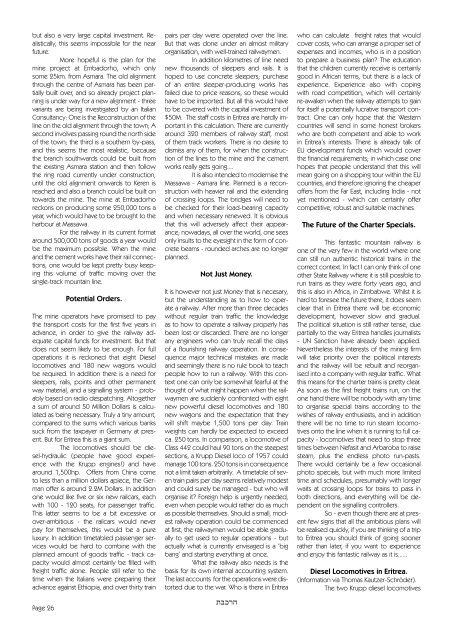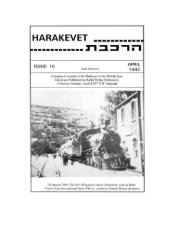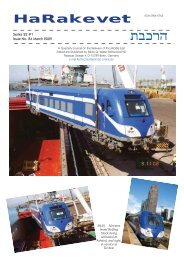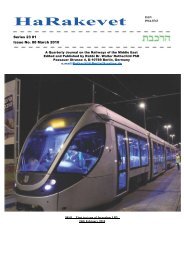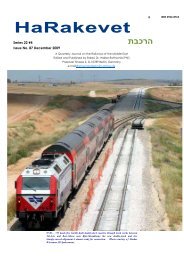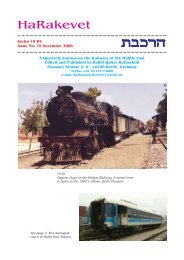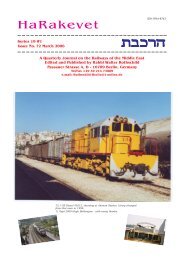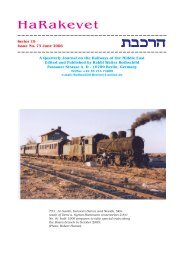You also want an ePaper? Increase the reach of your titles
YUMPU automatically turns print PDFs into web optimized ePapers that Google loves.
ut also a very large capital investment. Realistically,<br />
this seems impossible for the near<br />
future.<br />
More hopeful is the plan for the<br />
mine project at Embadorho, which only<br />
some 25km. from Asmara. The old alignment<br />
through the centre of Asmara has been partially<br />
built over, and so already project planning<br />
is under way for a new alignment - three<br />
variants are being investigated by an Italian<br />
Consultancy: One is the Reconstruction of the<br />
line on the old alignment through the town; A<br />
second involves passing round the north side<br />
of the town; the third is a southern by-pass,<br />
and this seems the most realistic, because<br />
the branch southwards could be built from<br />
the existing Asmara station and then follow<br />
the ring road currently under construction,<br />
until the old alignment onwards to Keren is<br />
reached and also a branch could be built on<br />
towards the mine. The mine at Embadorho<br />
reckons on producing some 250,000 tons a<br />
year, which would have to be brought to the<br />
harbour at Massawa.<br />
For the railway in its current format<br />
around 500,000 tons of goods a year would<br />
be the maximum possible. When the mine<br />
and the cement works have their rail connections,<br />
one would be kept pretty busy keeping<br />
this volume of traffic moving over the<br />
single-track mountain line.<br />
Page 26<br />
Potential Orders.<br />
The mine operators have promised to pay<br />
the transport costs for the first five years in<br />
advance, in order to give the railway adequate<br />
capital funds for investment. But that<br />
does not seem likely to be enough. For full<br />
operations it is reckoned that eight Diesel<br />
locomotives and 180 new wagons would<br />
be required. In addition there is a need for<br />
sleepers, rails, points and other permanent<br />
way material, and a signalling system - probably<br />
based on radio despatching. Altogether<br />
a sum of around 50 Million Dollars is calculated<br />
as being necessary. Truly a tiny amount,<br />
compared to the sums which various banks<br />
suck from the taxpayer in Germany at present.<br />
But for Eritrea this is a giant sum.<br />
The locomotives should be diesel-hydraulic<br />
(people have good experience<br />
with the Krupp engines!) and have<br />
around 1,500hp. Offers from China come<br />
to less than a million dollars apiece, the German<br />
offer is around 2.2M Dollars. In addition<br />
one would like five or six new railcars, each<br />
with 100 - 120 seats, for passenger traffic.<br />
This latter seems to be a bit excessive or<br />
over-ambitious - the railcars would never<br />
pay for themselves, this would be a pure<br />
luxury. In addition timetabled passenger services<br />
would be hard to combine with the<br />
planned amount of goods traffic - track capacity<br />
would almost certainly be filled with<br />
freight traffic alone. People still refer to the<br />
time when the Italians were preparing their<br />
advance against Ethiopia, and over thirty train<br />
pairs per day were operated over the line.<br />
But that was done under an almost military<br />
organisation, with well-trained railwaymen.<br />
In addition kilometres of line need<br />
new thousands of sleepers and rails. It is<br />
hoped to use concrete sleepers; purchase<br />
of an entire sleeper-producing works has<br />
failed due to price reasons, so these would<br />
have to be imported. But all this would have<br />
to be covered with the capital investment of<br />
$50M. The staff costs in Eritrea are hardly important<br />
in this calculation. There are currently<br />
around 320 members of railway staff, most<br />
of them track workers. There is no desire to<br />
dismiss any of them, for when the construction<br />
of the lines to the mine and the cement<br />
works really gets going....<br />
It is also intended to modernise the<br />
Massawa - Asmara line. Planned is a reconstruction<br />
with heavier rail and the extending<br />
of crossing loops. The bridges will need to<br />
be checked for their load-bearing capacity<br />
and when necessary renewed. It is obvious<br />
that this will adversely affect their appearance;<br />
nowadays, all over the world, one sees<br />
only insults to the eyesight in the form of concrete<br />
beams - rounded arches are no longer<br />
planned.<br />
Not Just Money.<br />
It is however not just Money that is necesary,<br />
but the understanding as to how to operate<br />
a railway. After more than three decades<br />
without regular train traffic the knowledge<br />
as to how to operate a railway properly has<br />
been lost or discarded. There are no longer<br />
any engineers who can truly recall the days<br />
of a flourishing railway operation. In consequence<br />
major technical mistakes are made<br />
and seemingly there is no rule book to teach<br />
people how to run a railway. With this context<br />
one can only be somewhat fearful at the<br />
thought of what might happen when the railwaymen<br />
are suddenly confronted with eight<br />
new powerful diesel locomotives and 180<br />
new wagons and the expectation that they<br />
will shift maybe 1,500 tons per day. Train<br />
weights can hardly be expected to exceed<br />
ca. 250 tons. In comparison, a locomotive of<br />
Class 442 could haul 90 tons on the steepest<br />
sections, a Krupp Diesel loco of 1957 could<br />
manage 100 tons. 250 tons is in consequence<br />
not a limit taken arbitrarily. A timetable of seven<br />
train pairs per day seems relatively modest<br />
and could surely be managed - but who will<br />
organise it? Foreign help is urgently needed,<br />
even when people would rather do as much<br />
as possible themselves. Should a small, modest<br />
railway operation could be commenced<br />
at first, the railwaymen would be able gradually<br />
to get used to regular operations - but<br />
actually what is currently envisaged is a ‘big<br />
bang’ and starting everything at once.<br />
What the railway also needs is the<br />
basis for its own internal accounting system.<br />
The last accounts for the operations were distorted<br />
due to the war. Who is there in Eritrea<br />
,cfrv<br />
who can calculate freight rates that would<br />
cover costs, who can arrange a proper set of<br />
expenses and incomes, who is in a position<br />
to prepare a business plan? The education<br />
that the children currently receive is certainly<br />
good in African terms, but there is a lack of<br />
experience. Experience also with coping<br />
with road competition, which will certainly<br />
re-awaken when the railway attempts to gain<br />
for itself a potentially lucrative transport contract.<br />
One can only hope that the Western<br />
countries will send in some honest brokers<br />
who are both competent and able to work<br />
in Eritrea’s interests. There is already talk of<br />
EU development funds which would cover<br />
the financial requirements; in which case one<br />
hopes that people understand that this will<br />
mean going on a shopping tour within the EU<br />
countries, and therefore ignoring the cheaper<br />
offers from the Far East, including India - not<br />
yet mentioned - which can certainly offer<br />
competitive, robust and suitable machines.<br />
The Future of the Charter Specials.<br />
This fantastic mountain railway is<br />
one of the very few in the world where one<br />
can still run authentic historical trains in the<br />
correct context. In fact I can only think of one<br />
other State Railway where it is still possible to<br />
run trains as they were forty years ago, and<br />
this is also in Africa, in Zimbabwe. Whilst it is<br />
hard to foresee the future there, it does seem<br />
clear that in Eritrea there will be economic<br />
development, however slow and gradual.<br />
The political situation is still rather tense, due<br />
partially to the way Eritrea handles journalists<br />
- UN Sanction have already been applied.<br />
Nevertheless the interests of the mining firm<br />
will take priority over the political interests<br />
and the railway will be rebuilt and reorganised<br />
into a company with regular traffic. What<br />
this means for the charter trains is pretty clear.<br />
As soon as the first freight trains run, on the<br />
one hand there will be nobody with any time<br />
to organise special trains according to the<br />
wishes of ralway enthusiasts, and in addition<br />
there will be no time to run steam locomotives<br />
onto the line when it is running to full capacity<br />
- locomotives that need to stop three<br />
times between Nefasit and Arbaroba to raise<br />
steam, plus the endless photo run-pasts.<br />
There would certainly be a few occasional<br />
photo specials, but with much more limited<br />
time and schedules, presumably with longer<br />
waits at crossing loops for trains to pass in<br />
both directions, and everything will be dependent<br />
on the signalling controllers.<br />
So - even though there are at present<br />
few signs that all the ambitious plans will<br />
be realised quickly, if you are thinking of a trip<br />
to Eritrea you should think of going sooner<br />
rather than later, if you want to experience<br />
and enjoy this fantastic railway as it is......<br />
Diesel Locomotives in Eritrea.<br />
(Information via Thomas Kautzer-Schröder).<br />
The two Krupp diesel locomotives


